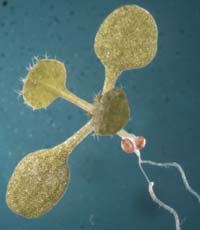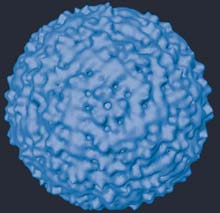Articles and reports from the Life Sciences and chemistry area deal with applied and basic research into modern biology, chemistry and human medicine.
Valuable information can be found on a range of life sciences fields including bacteriology, biochemistry, bionics, bioinformatics, biophysics, biotechnology, genetics, geobotany, human biology, marine biology, microbiology, molecular biology, cellular biology, zoology, bioinorganic chemistry, microchemistry and environmental chemistry.

By taking a fresh approach to an old problem, University of California, San Diego biologists and colleagues at other institutions have found a new gene essential for plant growth, a discovery that could lead to the design of better herbicides and even novelty plants.
Despite 100 years of research on auxin, a plant hormone essential in regulating plants’ development and responses to their surroundings, including the ability of plants to grow toward light, much remains unknown about how auxin

Large-scale genetic research carried out by Russian and American scientists have proved that contemporary mankind originated from a very small group of people. Common ancestors have been discovered for the entire population of many billions inhabiting all five continents of the Earth: these are two thousand primeval hunters-gatherers who used to live in Africa more than 100,000 years ago. New data has been also obtained about the rates and directions of human beings’ prehistoric evolution, and the wa

Walking down a dark alley late at night is enough to give anyone the heebie-jeebies. Your heart starts racing, your palms get clammy and you get ready to run. Now researchers from Boston University have unravelled the neural pathways that transmit information about your surroundings to your organs, enabling them to respond appropriately.
The research, to be published on Friday in BMC Neuroscience, has shown that neurons originating in high-order brain structures transmit signals about the

Dutch researcher Annelieke Franke has discovered that the aging of the brain adversely affects the fertility of female rats. The scientist suspects that her research will provide insights into fertility problems of women over the age of 30.
Franke studied relatively young subfertile rats. Although the pituitary gland and ovaries of these rats still functioned normally, their brains had already started to function differently. This led Franke to conclude that the ageing of the brain reduces f

Fly genetics may increase understanding of human hearing disorders
Researchers at the University of Wisconsin Medical School have found genetic evidence linking humans and fruit flies in a new way: through their hearing. The link offers the future possibility that the insect’s auditory system may serve as a model for understanding human deafness and other hearing disorders.
The scientists found that a mutated fruit fly gene controlling hearing and the mutated human coun

Purdue University biologists have determined the structure of the West Nile virus, a development that could greatly augment our understanding of the virus’ life cycle.
Using cryoelectron microscopy and advanced imaging techniques, the Purdue team has determined the orientation of the major surface proteins in a West Nile viral particle. Because these proteins are instrumental in allowing the virus to bind to and invade a host cell, the research could be a step forward in combating the